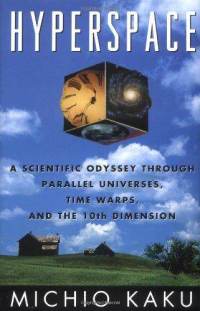The Influence of Space and Time
 Michio Kaku is one of my first major influences, my physics rock star. He wrote Hyperspace, which explained theories of spacetime and multiple dimension theory in an understandable way. Though Madeleine L'Engle's A Wrinkle in Time was the gateway that nudged me to explore impossible things, Michio Kaku was the author of my confidence to explore complex matters normally reserved for geniuses. Though my perspective on these topics has changed greatly since this book, I would still highly recommend it to anyone who wants a stepping stone to exploring the possibilities of the world around us.
Michio Kaku is one of my first major influences, my physics rock star. He wrote Hyperspace, which explained theories of spacetime and multiple dimension theory in an understandable way. Though Madeleine L'Engle's A Wrinkle in Time was the gateway that nudged me to explore impossible things, Michio Kaku was the author of my confidence to explore complex matters normally reserved for geniuses. Though my perspective on these topics has changed greatly since this book, I would still highly recommend it to anyone who wants a stepping stone to exploring the possibilities of the world around us.Nature's Creator
Andy Goldsworthy doesn't paint with acrylics or oils, he paints with leaves, icicles, twigs, mud, stones, holes, balance, and pressure. He paints with nature itself. Using only what he has around him, his work may only last a few hours, or mere minutes. Taken by tide, melted, windblown, eroded, the most lasting impression of his work may be a photograph, if he chooses to make one. Understanding that his works are made entirely with nature's materials makes it all the more impressive. Extremely simple, yet stunning; incredibly complex, yet temporary. What makes his work most striking is the clear organization amongst chaotic surroundings. Seeing how long they last is part of the experiment. The relationship of stability and permanence of his works is great fodder for meditation.His creations show how simple reorganizations will give rise to objects of awe. It is of a genius easily passed by casual onlookers. The depth, intensity, and patience in his work is extraordinary.




I highly encourage you to check out a gallery of his work here to see what may strike you.
Rethink
Social commentary, irony, freedom, societal introspection. These are the topics and conveyances in much of Banksy's art. It lays bare the conflict between society, its citizens, and its keepers. The cracks in our structure that we'd be all too comfortable to ignore. These are made open to ponder, if we don't mind being uncomfortable for a few moments. Mostly, it should give cause to rethink. His methods influenced by Warhol and graffiti, his meanings influenced by internal compass. Banksy is the Batman of art. He is a street artist who kept a necessary secret identity, all the while posing as a playboy benefactor.




Check out a gallery of his work here to see if there's anything that doesn't strike you.
Where the Heck is Matt?
A regular guy with ideals and ideas. Matt Harding was tired of his routine as a video game engineer. He "didn't want to spend two years of my life writing a game about killing everyone," so he quit his job and began traveling. A friend asked him to dance a jig once while filming, and the dance went on to each place he visited. As you will see in the videos, it became much more than that.| Dance with it in full screen! |
What else can we learn from Matt? Well...maybe you only do one thing well. Maybe it seems insignificant like dancing, reading, cooking, charades, or blogging. Just keep doing it. Evolve it. Though you may never be world renowned, you may find a way to bring joy to someone, and with any luck, you could bring joy to many someones.
My inspirations are based on what I take from their efforts. Are you familiar with any of these strangers of significance? If so, what did you take from their work?